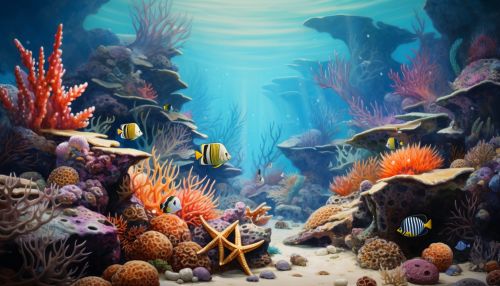Reproductive Strategies in Marine Invertebrates
Overview
Marine invertebrates, a diverse group of organisms that inhabit the world's oceans, have developed a wide array of reproductive strategies to ensure their survival. These strategies, which include both sexual and asexual reproduction, are influenced by a variety of environmental factors and have significant implications for the population dynamics and genetic diversity of these species.


Sexual Reproduction
Sexual reproduction in marine invertebrates involves the production of gametes (eggs and sperm) and the fusion of these gametes to form a zygote. This mode of reproduction can occur through both internal and external fertilization, depending on the species.
Internal Fertilization
Internal fertilization, where fertilization of the egg by the sperm occurs inside the body of the female, is a common reproductive strategy in many marine invertebrates such as certain species of cephalopods and gastropods. This method often involves complex mating behaviors and adaptations for sperm transfer.
External Fertilization
External fertilization, on the other hand, involves the release of gametes into the water where fertilization occurs. This strategy is common in many species of echinoderms and cnidarians. External fertilization often results in a high number of offspring, but these offspring may be subject to high predation rates and other environmental pressures.
Asexual Reproduction
Asexual reproduction, where an individual produces offspring without the involvement of another individual, is another common reproductive strategy in marine invertebrates. This can occur through several methods, including budding, fragmentation, and parthenogenesis.
Budding
Budding is a form of asexual reproduction where a new individual grows out of the body of the parent. This is common in many species of sponges and cnidarians.
Fragmentation
Fragmentation, where a piece of the parent organism breaks off and develops into a new individual, is another form of asexual reproduction. This is common in many species of echinoderms and annelids.
Parthenogenesis
Parthenogenesis, where an egg develops into a new individual without being fertilized, is less common but does occur in some marine invertebrates such as certain species of copepods and ostracods.
Factors Influencing Reproductive Strategies
The reproductive strategies of marine invertebrates are influenced by a variety of environmental factors. These include temperature, salinity, food availability, and predation pressure. For example, some species may switch between sexual and asexual reproduction depending on environmental conditions.
Implications for Population Dynamics and Genetic Diversity
The reproductive strategies of marine invertebrates have significant implications for their population dynamics and genetic diversity. For example, sexual reproduction can increase genetic diversity and allow for adaptation to changing environments, while asexual reproduction can allow for rapid population growth.
